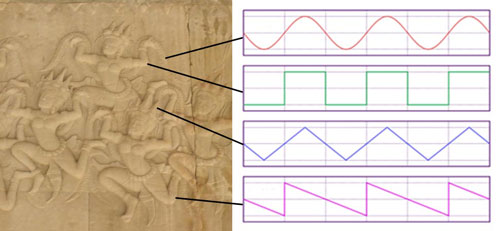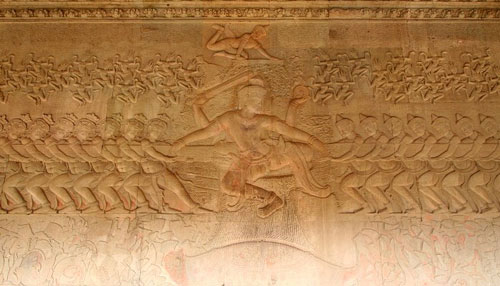Part II: Ancient World Science (Part 1 here)
The mainstream archeological community holds a common belief the technologies and sciences of the ancient world were inferior compared to ours today. Because these ideas are taught as common knowledge within text books for generations to learn many of today’s researchers believe they hold key evidence to back up their claims. In many cases for the sake of fame and fortune it has become apparent the ones lucky enough to have recognition will stand their ground at any costs. When I read some of their “popular” views how certain feats were accomplished in the ancient world it seems obvious they may not be completely correct on all levels. It’s already been brought to light with creditable evidence the ancient world science was far more advanced then so-called experts originally gave credit for. Thanks to certain individuals and groups who saw past these close-minded views we can observe evidence first hand of the sophistication it took the ancient people to build and align their monuments to certain astronomical events. What could’ve happened to the lost scientific knowledge used to calibrate these structures to such accuracy? In my opinion this will remain a mystery until someone can demonstrate the building methods to the precision of the Great Pyramid at Giza.
Back in the early 90’s when I first started research on the ancient world I was intrigued by the work of certain individuals who saw past the mainstream views. In the beginning it was Graham Hancock and Robert Bauval who inspired me the most. They made it easy to see past the accepted views with a well thought out and very convincing theory. Bauval introduced the idea the pyramid layout at Giza can be connected to the star constellation Orion while Hancock presented evidence of an advanced civilization that was lost in time around 10,450 BC. Using the pyramids as a marker in time they are thought to have a direct astronomical connection to this lost civilization. Even though critics can’t explain the true meaning of the pyramid layout they still speak out against these different ideas. Despite their criticism the hypothesis and evidence of a lost civilization immediately opened up doors to new ideas.
Another idea which captured my attention was one John Anthony West with the help of Robert Schoch brought to the world’s attention. Their observations and evidence of the Great Sphinx and the idea its erosion was caused by heavy rainfalls was very convincing. Scientists believe heavy rainfalls haven’t occurred in that area for over 10,000 years and it seems more than a coincidence the Great Sphinx faces the constellation Leo during the rising sun around the same time. The combination of these theories had me intrigued I couldn’t help but imagine only an advanced technology could achieve this. If these theories were correct then not only is there a lost civilization but there would have to be a lost science as well. One thing is obvious to me when peering into the past the accomplishments of the ancient people seem to be of a completely different nature than what we achieve today.
In our modern era we feel we have an advanced society compared to just a few hundred years ago. With our high tech electronics and world-wide-web we live in a time when information can be passed around in the matter of minutes. The changes over the past few hundred years have been phenomenal but looking through written history before these times the changes seemed to be at a much slower pace. Even by these standards imagine how it was thousands of years ago. Their societies should be far behind us and our technological wonders. When I observe the building techniques of the ancient world this idea becomes hard to grasps. The first and most obvious thing I noticed was all of these different civilizations spread out over long distances and during different time periods used the same building materials and techniques to construct their cities. It didn’t make sense to me all of these different cultures would use the hardest building methods they could possibly think of without any kind of advanced system to accomplish these feats.
It seems many ancient civilizations have the same story or legend how the population that once filled these lost cities mysterious vanished. What actually happened to each culture has been a complete mystery and one can only speculate with the evidence left behind. After hundreds and sometimes thousands of years these mysterious places being hidden in the jungles, buried in the sand or covered with water are discovered by explorers. After the examination of these ancient sites scientists and discoverers of the time needed answers to fit with the timeline they already held strong beliefs in. For this reason vital clues and evidence were either ignored or in some cases destroyed. The true meaning of how these mysterious accomplishments were achieved is, in my opinion, still unsolved. In reality what’s taught in text books is only speculation and no one really knows for sure what happened to these ancient cities or the populations that once thrived in them. It is possible these civilizations could have had an entirely different scientific approach that was lost in time with no creditable way to prove it. This is why I find it very important to pay attention to all the evidence left behind and always use an open mind to any possibilities.
Many ancient monuments show signs their builders had the knowledge and capability to harness sound. The ancient Romans knew the exact dimensions for building a perfectly acoustic amphitheater. It is said an actor could drop a pin and it would be heard from the very back row. How did they achieve this mastery of sound mechanics? The Grand Gallery of the Great Pyramid in Egypt is said to have perfect acoustical properties as well. Newgrange and Fourknocks in Ireland almost seems as though they’re a hall of records for sound acoustics. There are numerous sites throughout the ancient world where acoustical studies are being performed today. I see this as evidence sound must have played an important role in the lost science of the ancient world. Realizing how important waves are in our scientific community today I started my research in this area. With these ideas I started looking for clues within art among other evidence that may connect sound to the ancient sites in question and I was amazed at what I found.
When I study clues left behind from the ancients I see a different world then the more popular views described by scholars. Observing the evidence in the form of art or even the building techniques I have no doubt there was a totally different way of achieving these things in the past. When I see ancient art on the walls of numerous sites throughout the world I see what appears to be a pattern or code of a lost and sophisticated science. Starting with ancient cave art and rock art there was a fascination with waveforms and swirl patterns that seemed to cover the globe. This had me thinking maybe some of the cave dwellers were actually survivors of an advanced race that somehow perished. How else would they have the capability to develop knowledge of waves? It seems more than coincidence wave patterns are seen in art from Europe to America and even in Australia. When observing the decorated walls of ancient cities I noticed even their art seemed to focus on wave patterns. A perfect example of this is the walls of Angkor Wat and Angkor Thom in Cambodia. It seems they are obvious on much of the Egyptian and Mayan walls as well. Why would the ancients continuously repeat this same pattern unless it had some significant impact on their lives?
Observations of Ancient Man
Many ancient civilizations provided evidence they knew precisely how to create realistic statues and art. So why did some choose to purposely distort their art with what appears to be unrealistic scenes? I considered that maybe there’s a scientific formula embedded within these different scenes. Just as Leonardo da Vinci was said to have hidden codes within his work maybe the ancient people used the same method. Only to them it wasn’t a code but a common knowledge that was easy for them to understand. Could this be how they passed along their knowledge much the same way we use text books and websites today?
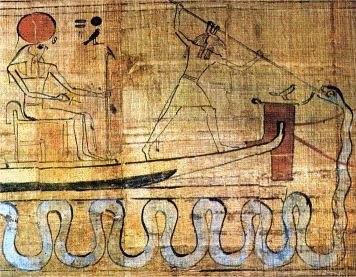
When I observe art from any ancient culture I see a repeat of the same ideas over and over sometimes in patterns. It’s believed these ideas are religious in meaning but I wonder if it’s more scientific. In this scene a boat is floating above a huge snake which bears the form of a sine wave. There also appears to be important angles throughout that could be used for different purposes such as alignment of planets or stars.
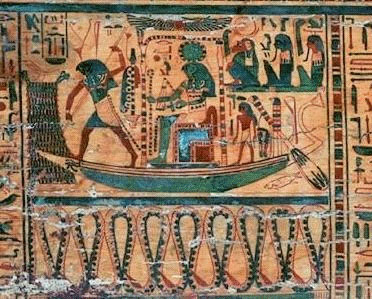
Here is another example of a boat floating above a snake which is in the shape of a sine wave. The layout of this type of artwork appears to be a code or mathematical in nature. When you look at the different sections it appears to be broken up into different meanings or perhaps equations. Could these scenes been deciphered using the wrong ideas? Or could they have multiple meanings? If so, what could be the true definition behind these works of art?
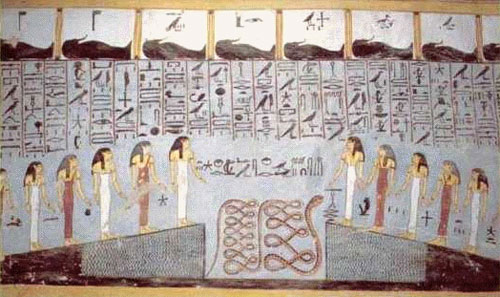
What appears to be a snake pit at the center of the scene above can be compared to standing S-waves as described in Part One. It seems odd to me the snake appears to be in an unnatural and unrealistic position. What could this be describing? Could it be the behavior of standing waves or possibly the movement of a planet or star in the night’s sky?
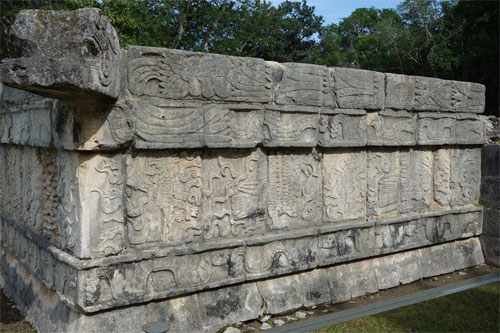
This is one of many Mayan sites that depict snakes in the form of waves. What was the fascination with snakes in many of the ancient cultures? Could it be a religious symbol or maybe the perfect symbol to describe the behavior of waves? If this is the case maybe they were used to describe how forces react to one another. I’ve been pondering on this idea for quite a while. At first it didn’t seem to make sense but after comparing some scenes to modern science I could see some similarities. For example, besides snakes some cultures have different types of figures which some think of as hybrids or gods. Maybe these are describing a few different properties to a scientific formula. Like for instance, the wings or any other animal body parts may have a certain scientific property and when combined with other parts creates a formula. You could think of hybrids as scientific equations in the form of images.
In the scene above the two serpents in the form of sine waves appear to be moving away from one another. It appears the swirl shapes in the center could be describing repelling forces. This type of scene can be compared to “The Churning of the Milky Ocean” in Cambodia with the two snakes resembling the two groups of figures that are pulling the serpent.
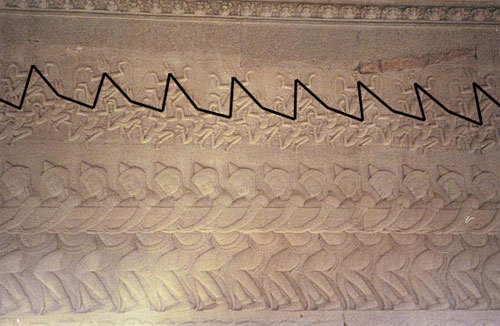
Angkor Wat is said to be the largest religious temple in the world. It may be true legends hold a key to the explanation of the endless scenes on its walls but what if important parts of the story were lost in time? From the beginning it was easy for me to recognize “The Churning of the Milky Ocean” is of high sophistication and importance. At the top of the scene female figures appear to be dancing or maybe flying through the air. When tracing a line from one figures head to the next the entire layout is in a wave pattern as seen above. If the direction the figures are moving is an indication of which way the waves are traveling they would be moving from the center out just as described in the Mayan scene. I see this repeated in many other cultures as well which indicate it’s of a global interest.
Even the snakes carried by these figures are in the form of sine waves. Some of the most basic waveforms can be seen in this image. The arms appear to be in the form of square waves while their legs resemble the saw-tooth waveform. Could this be an indication smaller groups of waves are moving within a larger wave? You could think of this as ripples or vibrations moving through a stronger current of energy.
On a larger scale when observing the entire layout I see a description of something far more advanced. This scene can be used as a calendar but also seems to describe the different forces that pull the Earth through its orbit. I say this for several reasons, if you count all of the figures including the larger ones they can be used to represent each day of a half year. The larger figures at each end represent the winter and summer solstice while the king at the center represents the spring equinox. The larger figures in-between represent the remaining months making this a six month calendar or half year. Notice the figures that are pulling the serpent, each side is leaning their heads towards the center indicating the energy is moving in that direction. But notice on both sides their legs lean in the same direction. To me this is a sign energy from their legs are all pushing in the same direction. Also note the king in the center appears to have his left leg adjoined to the serpent and is being pulled harder to the right. If you were to take this as the right side having a slight advantage over the left these forces can describe the Earth being pulled through its orbit from winter to summer solstice. The object behind the king the serpent appears to be wrapped around is thought to be a mountain which could represent Earth. If the majority of the energy is pulling to the right with the serpent being behind the mountain on the left and in front of it on the right as it appears in the scene the rotation would be the same as the Earth’s.
According to legend the mountain is churning the milky ocean from the two sides pulling the serpent back and forth. From the start I was thinking this ancient calendar is only for half year but if you were to reverse the calendar after reaching the summer solstice it can be used to continue the rest of the year. When reading it backwards the center figure would represent the fall equinox. This would explain the churning motion that legend says moves back and forth. Also can be compared to a wave that reflects from a hard surface back to its source as described in part one. Notice in the image above the direction the mountain rotates would remain the same when being pulled in either direction. After realizing the different movements coincide with the Earth as it moves through its orbit I figured this scene has more meaning than just a story about a king. Maybe it has multiple meanings and goes deeper telling the same story of balance only on a far larger scale.
These images are just a few of the numerous examples I’ve noticed that depict wave patterns within ancient scenes. Could they hold the key to a lost science or could they simply be religious and tell stories of gods? One thing is for certain the ancient people no matter where they resided all seem to have certain aspects which can be compared to one another. There are too many coincidences for me to believe each civilization where unaware of each other. I figured if this is true we are being led down the wrong path by centuries of misinformation. I’m not claiming to know exactly what happen in the past or what the art was meant to represent but I hold a strong belief that we are missing a major part of the story of mankind which involves a lost scientific knowledge. I wasn’t taught with college textbooks in which, at times, regardless of the evidence provide only one answer. I believe this is what enables me to think “outside the box”. My theories consist of research using observations within nature or evidence left behind by ancient man and combine them with ideas from modern science. I feel that in order for us to move forward we must challenge the system with new ideas and accept change.
This is only a small portion of my research which goes much deeper. I am in the process of seeking a publisher. If anyone is or may know someone interested in publishing my book please contact me at [email protected] Thank you for reading.






